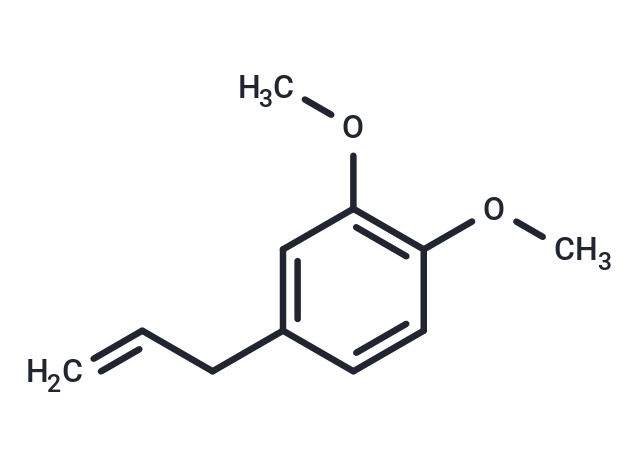- Remove All
 Your shopping cart is currently empty
Your shopping cart is currently empty
Methyl eugenol
1. Methyl eugenol (4-allylveratrole) is a natural constituent of the essential oils of a number of plants widely used in foodstuffs as flavouring agents, in view of the carcinogenic potential of ME, the need to check its presence in food products with effective analytical methods. 2. Methyleugenol has insecticidal properties. 3. Methyleugenol can inhibit the production of nitric oxide and decreased the protein expression of inducible nitric oxide synthase, it down-regulates the production of pro-inflammatory cytokines in the ischemic brain as well as in immunostimulated mixed glial cells; indicates that methyleugenol could be useful for the treatment of ischemia/inflammation-related diseases. 4. Methyleugenol has cytotoxicity and genotoxicity. 5. Intravenous (i.v.) treatment with methyleugenol (ME) in either anesthetized or conscious rats elicits hypotension, an effect that seems related to an active vascular relaxation rather than withdrawal of sympathetic tone. 6. Methyleugenol has antinociceptive effect on the second phase of formalin-induced pain, may be due to the inhibition of N-methyl-d-aspartic acid (NMDA) receptor-mediated hyperalgesia via GABA(A) receptors. 7. Methyleugenol has elaxant and antispasmodic actions on guinea-pig isolated ileum.

Methyl eugenol
| Pack Size | Price | Availability | Quantity |
|---|---|---|---|
| 100 mg | $39 | In Stock | |
| 500 mg | $91 | In Stock | |
| 5 g | $325 | In Stock | |
| 1 mL x 10 mM (in DMSO) | $43 | In Stock |
Product Introduction
| Description | 1. Methyl eugenol (4-allylveratrole) is a natural constituent of the essential oils of a number of plants widely used in foodstuffs as flavouring agents, in view of the carcinogenic potential of ME, the need to check its presence in food products with effective analytical methods. 2. Methyleugenol has insecticidal properties. 3. Methyleugenol can inhibit the production of nitric oxide and decreased the protein expression of inducible nitric oxide synthase, it down-regulates the production of pro-inflammatory cytokines in the ischemic brain as well as in immunostimulated mixed glial cells; indicates that methyleugenol could be useful for the treatment of ischemia/inflammation-related diseases. 4. Methyleugenol has cytotoxicity and genotoxicity. 5. Intravenous (i.v.) treatment with methyleugenol (ME) in either anesthetized or conscious rats elicits hypotension, an effect that seems related to an active vascular relaxation rather than withdrawal of sympathetic tone. 6. Methyleugenol has antinociceptive effect on the second phase of formalin-induced pain, may be due to the inhibition of N-methyl-d-aspartic acid (NMDA) receptor-mediated hyperalgesia via GABA(A) receptors. 7. Methyleugenol has elaxant and antispasmodic actions on guinea-pig isolated ileum. |
| Alias | O-methyleugenol, eugenyl methyl ether, Eugenol Methyl ether, 4-allylveratrole |
| Molecular Weight | 178.23 |
| Formula | C11H14O2 |
| Cas No. | 93-15-2 |
| Smiles | O(C)C1=C(OC)C=CC(CC=C)=C1 |
| Relative Density. | 1.032 - 1.036 g/cm3. Temperature:25 °C. |
| Storage | keep away from direct sunlight | Powder: -20°C for 3 years | In solvent: -80°C for 1 year | Shipping with blue ice. | |||||||||||||||||||||||||||||||||||
| Solubility Information | DMSO: 70 mg/mL (392.75 mM), Sonication is recommended. | |||||||||||||||||||||||||||||||||||
Solution Preparation Table | ||||||||||||||||||||||||||||||||||||
DMSO
| ||||||||||||||||||||||||||||||||||||
Sci Citations
Calculator
In Vivo Formulation Calculator (Clear solution)
Dose Conversion
Tech Support

Copyright © 2015-2025 TargetMol Chemicals Inc. All Rights Reserved.



